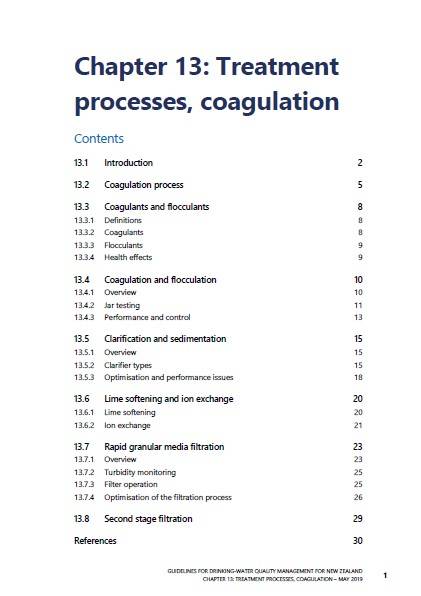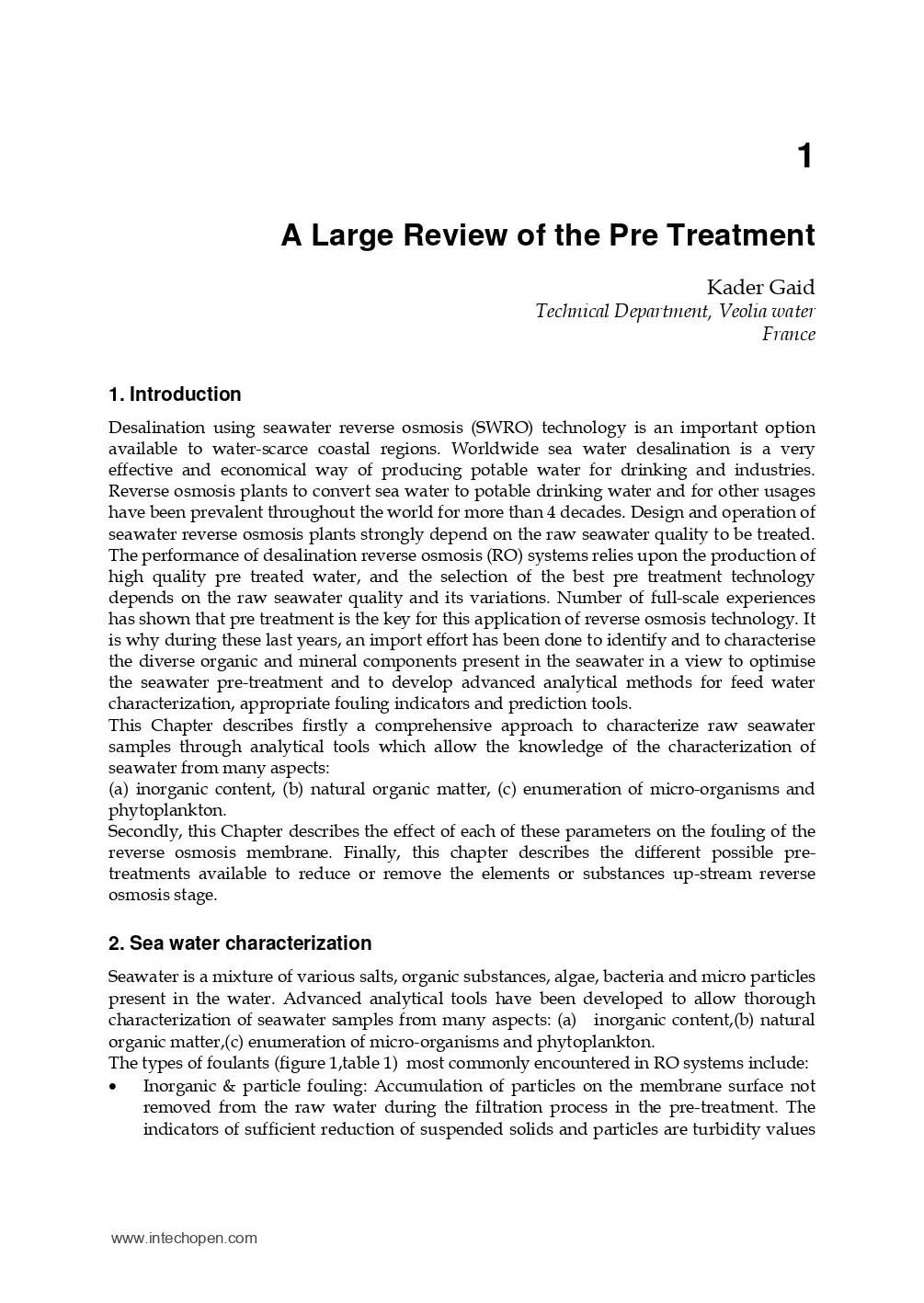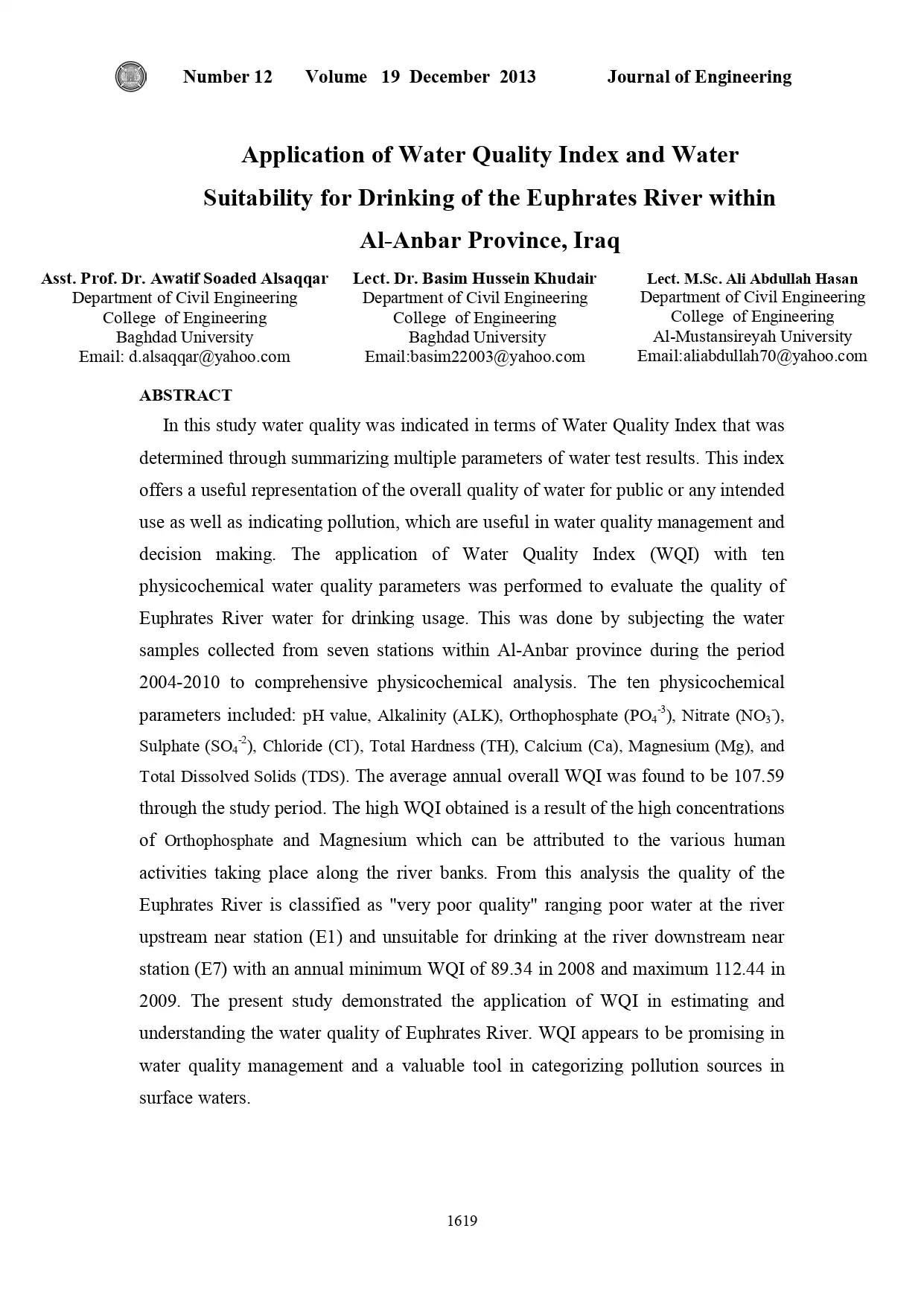Guidelines For Drinking-Water Quality Management For New Zealand – Chapter 13: Treatment Processes Coagulation
Credit to: https://www.health.govt.nz/
Usually dispatched in 2 to 3 days
Usually dispatched in 2 to 3 days
Category:
Drinking Water Treatment
Only logged in customers who have purchased this product may leave a review.
Related products
Module 11: Administration of Water Treatment Plants
• Describe how water treatment plants comply with their minimum federal and state monitoring requirements.
• List the three ways in which management ensures that the staff complies with monitoring requirements.
• Discuss reporting requirements when complying with federal and state regulations.
Module 11: Administration of Water Treatment Plants
• Describe how water treatment plants comply with their minimum federal and state monitoring requirements.
• List the three ways in which management ensures that the staff complies with monitoring requirements.
• Discuss reporting requirements when complying with federal and state regulations.
A Large Review of the Pre Treatment
Introduction:
Desalination using seawater reverse osmosis (SWRO) technology is an important option available to water-scarce coastal regions. Worldwide sea water desalination is a very effective and economical way of producing potable water for drinking and industries. Reverse osmosis plants to convert sea water to potable drinking water and for other usages have been prevalent throughout the world for more than 4 decades. Design and operation of seawater reverse osmosis plants strongly depend on the raw seawater quality to be treated. The performance of desalination reverse osmosis (RO) systems relies upon the production of high quality pre treated water, and the selection of the best pre treatment technology depends on the raw seawater quality and its variations. Number of full-scale experiences has shown that pre treatment is the key for this application of reverse osmosis technology. It is why during these last years, an import effort has been done to identify and to characterise the diverse organic and mineral components present in the seawater in a view to optimise the seawater pre-treatment and to develop advanced analytical methods for feed water characterization, appropriate fouling indicators and prediction tools. This Chapter describes firstly a comprehensive approach to characterize raw seawater samples through analytical tools which allow the knowledge of the characterization of seawater from many aspects: (a) inorganic content, (b) natural organic matter, (c) enumeration of micro-organisms and phytoplankton. Secondly, this Chapter describes the effect of each of these parameters on the fouling of the reverse osmosis membrane. Finally, this chapter describes the different possible pre treatments available to reduce or remove the elements or substances up-stream reverse osmosis stage.
A Large Review of the Pre Treatment
Introduction:
Desalination using seawater reverse osmosis (SWRO) technology is an important option available to water-scarce coastal regions. Worldwide sea water desalination is a very effective and economical way of producing potable water for drinking and industries. Reverse osmosis plants to convert sea water to potable drinking water and for other usages have been prevalent throughout the world for more than 4 decades. Design and operation of seawater reverse osmosis plants strongly depend on the raw seawater quality to be treated. The performance of desalination reverse osmosis (RO) systems relies upon the production of high quality pre treated water, and the selection of the best pre treatment technology depends on the raw seawater quality and its variations. Number of full-scale experiences has shown that pre treatment is the key for this application of reverse osmosis technology. It is why during these last years, an import effort has been done to identify and to characterise the diverse organic and mineral components present in the seawater in a view to optimise the seawater pre-treatment and to develop advanced analytical methods for feed water characterization, appropriate fouling indicators and prediction tools. This Chapter describes firstly a comprehensive approach to characterize raw seawater samples through analytical tools which allow the knowledge of the characterization of seawater from many aspects: (a) inorganic content, (b) natural organic matter, (c) enumeration of micro-organisms and phytoplankton. Secondly, this Chapter describes the effect of each of these parameters on the fouling of the reverse osmosis membrane. Finally, this chapter describes the different possible pre treatments available to reduce or remove the elements or substances up-stream reverse osmosis stage.
Aerogel & Iron-Oxide Impregnated Granular Activated Carbon Media For Arsenic Removal
The goal of this project is to validate proof-of-concept testing for iron enriched granular activated carbon (GAC) composites (aerogel-GAC or iron-oxide impregnated) as a viable adsorbent for removing arsenic from groundwater and conduct technical and economic feasibility assessments for these innovative processes. Specific project objectives include: • Conduct batch experiments for aerogel-GAC and Fe-oxide impregnated GAC composites to evaluate their performance removing arsenic.
• Evaluate Fe-GAC media performance in rapid small scale column tests (RSSCTs) to assess arsenic removal in a more dynamic treatment system.
• Evaluate Fe-GAC potential for removal of other contaminants (e.g., methyl tertiary butyl ether, dissolved organic carbon).
• Characterize Fe-GAC media.
• Correlate performance and media characterization for possible selection of two media for a future second phase of this project.
Aerogel & Iron-Oxide Impregnated Granular Activated Carbon Media For Arsenic Removal
The goal of this project is to validate proof-of-concept testing for iron enriched granular activated carbon (GAC) composites (aerogel-GAC or iron-oxide impregnated) as a viable adsorbent for removing arsenic from groundwater and conduct technical and economic feasibility assessments for these innovative processes. Specific project objectives include: • Conduct batch experiments for aerogel-GAC and Fe-oxide impregnated GAC composites to evaluate their performance removing arsenic.
• Evaluate Fe-GAC media performance in rapid small scale column tests (RSSCTs) to assess arsenic removal in a more dynamic treatment system.
• Evaluate Fe-GAC potential for removal of other contaminants (e.g., methyl tertiary butyl ether, dissolved organic carbon).
• Characterize Fe-GAC media.
• Correlate performance and media characterization for possible selection of two media for a future second phase of this project.
Activated Carbon Treatment of Drinking Water
Introduction:
Activated carbon filtration (AC) is effective in reducing certain organic chemicals and chlorine in water. It can also reduce the quantity of lead in water although most lead-reducing systems use another filter medium in addition to carbon. Water is passed through granular or block carbon material to reduce toxic compounds as well as harmless taste- and odor-producing chemicals. This fact sheet discusses the principles and processes of typical activated carbon filtration systems.
Activated Carbon Treatment of Drinking Water
Introduction:
Activated carbon filtration (AC) is effective in reducing certain organic chemicals and chlorine in water. It can also reduce the quantity of lead in water although most lead-reducing systems use another filter medium in addition to carbon. Water is passed through granular or block carbon material to reduce toxic compounds as well as harmless taste- and odor-producing chemicals. This fact sheet discusses the principles and processes of typical activated carbon filtration systems.
Application of Water Quality Index and Water Suitability for Drinking of the Euphrates River within Al-Anbar Province, Iraq
In this study water quality was indicated in terms of Water Quality Index that was determined through summarizing multiple parameters of water test results. This index offers a useful representation of the overall quality of water for public or any intended use as well as indicating pollution, which are useful in water quality management and decision making. The application of Water Quality Index (WQI) with ten physicochemical water quality parameters was performed to evaluate the quality of Euphrates River water for drinking usage. This was done by subjecting the water samples collected from seven stations within Al-Anbar province during the period 2004-2010 to comprehensive physicochemical analysis.
Application of Water Quality Index and Water Suitability for Drinking of the Euphrates River within Al-Anbar Province, Iraq
In this study water quality was indicated in terms of Water Quality Index that was determined through summarizing multiple parameters of water test results. This index offers a useful representation of the overall quality of water for public or any intended use as well as indicating pollution, which are useful in water quality management and decision making. The application of Water Quality Index (WQI) with ten physicochemical water quality parameters was performed to evaluate the quality of Euphrates River water for drinking usage. This was done by subjecting the water samples collected from seven stations within Al-Anbar province during the period 2004-2010 to comprehensive physicochemical analysis.
Arsenic Removal From Drinking Water By Advanced Filtration Processes
All over the world the presence of arsenic in water sources for human consumption has been raising great concern in terms of public health since many epidemiologic studies confirm the potential carcinogenic effect of arsenic. Because arsenic removal is the most frequent option for safe drinking water, the development of more efficient and sustainable technologies is extremely important. Membrane separation processes are suitable for water treatment because they can provide an absolute barrier for bacteria and viruses, besides removing turbidity and colour. Their application is a promising technology in arsenic removal since it does not require the addition of chemical reagents nor the preliminary oxidation of arsenite required in conventional treatment options. However, since membrane technologies such as reverse osmosis can be a very expensive and unsustainable treatment option for small water supply
systems, it becomes crucial that alternative methods are developed. This work presents a few conclusions based on a laboratorial study performed to evaluate the efficiency of arsenic removal using ultrafiltration, microfiltration and solar oxidation processes under different experimental conditions for relevant parameters. The results showed removal efficiencies higher than 90%. Key-words: safe drinking water, arsenic removal, membranes, public health.
Arsenic Removal From Drinking Water By Advanced Filtration Processes
All over the world the presence of arsenic in water sources for human consumption has been raising great concern in terms of public health since many epidemiologic studies confirm the potential carcinogenic effect of arsenic. Because arsenic removal is the most frequent option for safe drinking water, the development of more efficient and sustainable technologies is extremely important. Membrane separation processes are suitable for water treatment because they can provide an absolute barrier for bacteria and viruses, besides removing turbidity and colour. Their application is a promising technology in arsenic removal since it does not require the addition of chemical reagents nor the preliminary oxidation of arsenite required in conventional treatment options. However, since membrane technologies such as reverse osmosis can be a very expensive and unsustainable treatment option for small water supply
systems, it becomes crucial that alternative methods are developed. This work presents a few conclusions based on a laboratorial study performed to evaluate the efficiency of arsenic removal using ultrafiltration, microfiltration and solar oxidation processes under different experimental conditions for relevant parameters. The results showed removal efficiencies higher than 90%. Key-words: safe drinking water, arsenic removal, membranes, public health.
Advancing Water, Sanitation and Hygiene (WASH) in Panchayats
Access to safe drinking water is critical to survival, and its deprivation could affect the health, food security, and livelihoods of human beings. India achieved 93% coverage of access to improved water supply in rural areas in 2015 towards fulfilling its commitment under the Millennium Development Goal1. However, with reference to safely managed drinking water (improved water supply located on-premises, available when needed and free of contamination) as per Sustainable Development Goal, India still has major targets to achieve, and is geared up to accomplish the same by the end of 2024. With the shift from the Millennium Development Goals (MDGs) to the Sustainable Development Goals (SDGs) less than half of the total rural households in the country have access to safely managed drinking water (improved water supply located on-premises, available when needed and free of contamination).
Advancing Water, Sanitation and Hygiene (WASH) in Panchayats
Access to safe drinking water is critical to survival, and its deprivation could affect the health, food security, and livelihoods of human beings. India achieved 93% coverage of access to improved water supply in rural areas in 2015 towards fulfilling its commitment under the Millennium Development Goal1. However, with reference to safely managed drinking water (improved water supply located on-premises, available when needed and free of contamination) as per Sustainable Development Goal, India still has major targets to achieve, and is geared up to accomplish the same by the end of 2024. With the shift from the Millennium Development Goals (MDGs) to the Sustainable Development Goals (SDGs) less than half of the total rural households in the country have access to safely managed drinking water (improved water supply located on-premises, available when needed and free of contamination).
Introduction to Water Treatment
This is an introduction to water treatment systems and technology. It is not a design manual or an exhaustive treatise. It is intended for engineers who are not regularly involved in water treatment projects, but who are interested in learning some of the basics involved. Criteria to be followed in determining the necessity for and the extent of treatment are discussed here, as are procedures applicable to the planning of water treatment projects.
Introduction to Water Treatment
This is an introduction to water treatment systems and technology. It is not a design manual or an exhaustive treatise. It is intended for engineers who are not regularly involved in water treatment projects, but who are interested in learning some of the basics involved. Criteria to be followed in determining the necessity for and the extent of treatment are discussed here, as are procedures applicable to the planning of water treatment projects.
A Study on the Introduction of Artificial Intelligence Technology in the Water Treatment Process
Today, we stand in front of a huge wave of change named the "Fourth industrial revolution." Key technologies of the Fourth Industrial Revolution include artificial intelligence, the Internet of Thing (IoT), cloud computing, big data analysis, etc. These technologies will lead to an intelligent information society, and platform services will change every aspect of society from economic and work. This paper proposes several introductions of Artificial Intelligence Technology to improve water management.
A Study on the Introduction of Artificial Intelligence Technology in the Water Treatment Process
Today, we stand in front of a huge wave of change named the "Fourth industrial revolution." Key technologies of the Fourth Industrial Revolution include artificial intelligence, the Internet of Thing (IoT), cloud computing, big data analysis, etc. These technologies will lead to an intelligent information society, and platform services will change every aspect of society from economic and work. This paper proposes several introductions of Artificial Intelligence Technology to improve water management.
Big Data Analysis For Studying Water Supply And Sanitation Coverage In Cities (Russia)
Big data analysis for water supply and sanitation is important for ensuring urban viability. Our research is devoted to studying the methodology for analyzing big data of the water supply and sanitation systems. Based on a review of scientific publications and their analysis, a model for analyzing large data was proposed. It comprises information sources, data collection and storage platforms with indication of parameters for the programming model, runtime and
storage environment, as well as data analysis and processing.
Big Data Analysis For Studying Water Supply And Sanitation Coverage In Cities (Russia)
Big data analysis for water supply and sanitation is important for ensuring urban viability. Our research is devoted to studying the methodology for analyzing big data of the water supply and sanitation systems. Based on a review of scientific publications and their analysis, a model for analyzing large data was proposed. It comprises information sources, data collection and storage platforms with indication of parameters for the programming model, runtime and
storage environment, as well as data analysis and processing.















Reviews
There are no reviews yet.